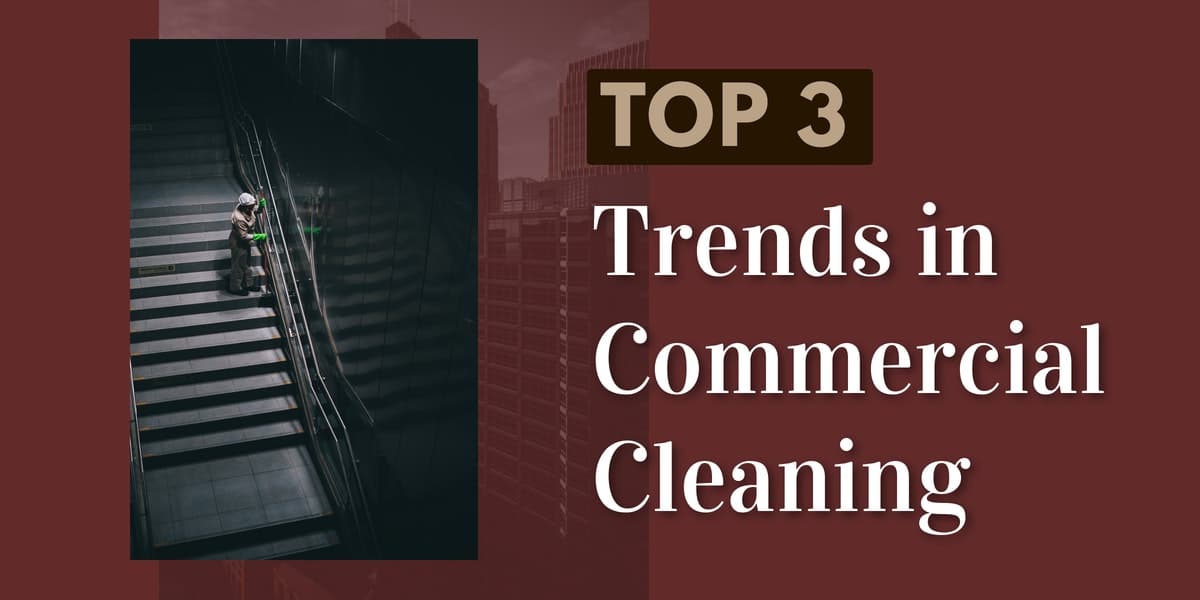Advancements in technology continue to drive down the prices for modern, high-performance automated cleaning systems and solutions while the demand for improvements in product safety and process sustainability is on the rise.

Rapidly Emerging Trends in Commercial Cleaning Services
Commercial cleaning services have long been plagued by the absence of innovative and disruptive products and services.
Take, for instance:
- The Yacht Mop - Commonly referred to as a cotton-string mop, dates back to as early as the 1400s.
- Chlorine-based Bleach - Dates back to late 18th-century Europe, and;
- Kitchen Sponges - The newest innovation on the list, was invented by DuPont in the early 1940s.
While these products did serve a vital purpose during their day, numerous studies have connected their use to dangerous levels of cross-contamination and exposure to toxic chemical fumes.
Yet, one would be hard-pressed to search through the cleaning closets of commercial businesses across America and not find these products collecting bacteria in the corner.
Coupled with the high turnover and absentee rates of custodial workers, customer churn, and a rapidly evolving workplace environment, the cleaning industry has long been overdue for a dramatic shift.
Fortunately, technology has caught up to consumer and industry demand in spectacular fashion, with emerging solutions fully capable of leveraging Bid Data and IoT solutions, robotic cleaning appliances, and a wide range of sustainable services and initiatives.
Big Data and IoT
IoT devices placed in strategic locations throughout a facility assist building service providers and custodial teams to deliver critical services to customers in a timely fashion, often before the occupant experiences any issues.
Big Data solutions analyze the information collected by IoT devices, providing facilities managers with a wealth of information regarding the use of supplies, the occupancy and traffic numbers of various areas of the facilities, and the functional performance of facility infrastructure.
A commonly employed example of this is monitored restrooms, which keep track of consumable products, such as soap, toilet paper, and paper towels, as well as the water flow through toilets and urinals, to ensure everything is in proper working condition and that occupants have all the toiletry necessities required at their disposal.
Additionally, Big Data systems can alert facilities managers and custodial staff to spikes in occupancy and traffic, allowing for the dispatch of service providers based on need, as opposed to a fairly arbitrary schedule, resulting in the more efficient use of resources, as well as increased customer satisfaction and profits.
Cleaning Robots
Automated floor scrubbers are a far cry from the expensive robotic vacuums you often encounter in consumer stores.
The systems are capable of:
- Mapping the floor.
- Identify obstacles.
- Determine the most efficient route, and;
- Recycle water.
All without the direct supervision of a facility service employee, resulting in further efficiency, resource use, and profit margins.
The robots can also report on the status of the various systems powering the device and notify the maintenance staff of issues or that it requires maintenance.
Sustainability Initiatives
The need for sustainable business practices become increasingly apparent every passing year, and it's not all about recycling and green cleaning.
Markets have become increasingly competitive, while operational budgets have become tighter to ensure maximum profits and viability.
Further, consumers have shown an increasing level of favoritism towards businesses that demonstrate a conscientious use of natural resources combined with a commitment to reduce waste.
While the implementation of recycling plans and environmentally-preferable products is a necessary part of these initiatives, the need for sustainable
- Industry partnerships
- Packaging and shipping methods
- Building design and construction
- Pest control
- Facility service and maintenance, and
- Waste deferment/product repurposing
are vital to the successful implementation of any sustainable program.
While these types of services can come with a hefty price tag, routinely advertising that your organization actively participates and promotes sustainable operations to the public has been shown to positively impact profit margins and customer satisfaction.
References & Resources
- 3 Trends In Professional Cleaning
- Everything You Wanted to Know About Mops but Were Afraid to Ask!
- Bleach
- The Value of Data-Driven Cleaning for the Facility Services Industry
- The Advantages of Robotic Cleaning
Takeaway
Commercial cleaning and facilities maintenance have come a long way over the last ten years, especially with the increased demand for healthier products and environmentally-safe practices that focus on waste reduction and resource management.
Establishing these programs can be costly, and are often subject to adoption failure without the proper planning and leadership.
Conversely, implementing them has been shown to address several of the critical issues that plague the cleaning industry.
Partnering with a dedicated service provider possessing the skills and experience necessary to navigate many of the pitfalls associated with the adoption of advanced cleaning and sustainable business programs will ensure your business is able to rapidly onboard and benefit from these services in short order.
Contact us today and discover why Vanguard Cleaning Systems® is the Standard of Clean® for businesses throughout Northwest Arkansas, Missouri, and Oklahoma.
In Oklahoma, dial 918-960-4450
In Arkansas, dial 479-717-2410
In Missouri, dial 417-812-9777
